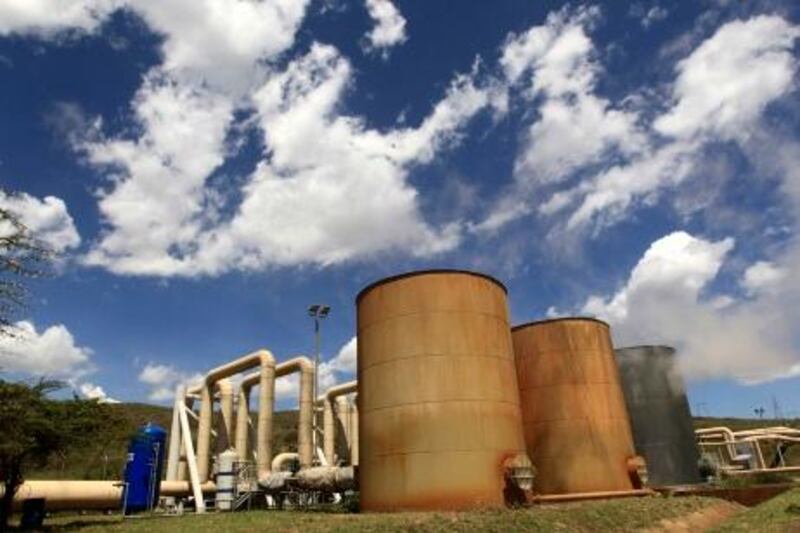NAiROBI // A recent conference in Nairobi, Kenya, was certainly a steamy affair.
For that was the main topic of conversation - how much it costs to explore for steam, how new technologies have reduced the cost to produce it, and how much it could boost the economy of East Africa.
What's the alternative?
Energy Join The National as it explores alternative to fossil fuels. Learn more
"We have been urged to think outside the box," said Silas Simiyu, the head of Kenya's Geothermal Development Company (GDC). "I think we should throw away the box."
Mr Simiyu is at the forefront of a movement in Kenya to utilise new technology to tap the country's significant geothermal resources. He argues that increasing geothermal capacity is necessary to meet the ambitious targets set in the government's 2030 strategy.
Kenya has 14 geothermal sites with the potential to produce between 7,000 megawatts and 15,000MW of power. To put that figure in context, Kenya currently generates 1,350MW of electricity from all sources (including 210MW from geothermal).
Geothermal energy is produced from water heated by the Earth's core. The heated water produces steam that can be used to drive a conventional turbine. It is the only alternative energy source that is currently cost-competitive with fossil fuels.
"Kenya's recent decision to go for geothermal as their future energy source for electricity sets an example for their neighbours and the world," says Ludvik Georgsson, the deputy director of UNU-GTP, a geothermal training programme in Iceland.
There is high potential for geothermal development across the region.
Last year, the African Rift Geothermal Development Facility (Argeo) was established to help accelerate the pace of geothermal development in six countries: Kenya; Tanzania; Ethiopia; Eritrea; Djibouti; and Uganda.
"Argeo's directive is to promote geothermal development through decreasing the risk associated with exploration and development of geothermal," says Meseret Zemedkun, the project manager of Argeo.
Thus far, the facility has convened energy ministers from the six countries to raise awareness and to show them Kenya's geothermal plants.
In the next five years, it plans to establish a regional database on geothermal resources, increase the number of skilled workers in the industry, and help establish a clear regulatory framework for individual countries and the region.
Argeo was funded with US$17.8 million (Dh65.3m) from the UN's Global Environment Fund, and it will primarily provide technical assistance. Because it is working with limited funding, it must leverage the work being done in individual countries to develop the geothermal industry.
Kenya is seen as a pioneer in geothermal development across Africa.
The first geothermal power plant in Africa, Olkaria I, was built in Kenya in 1981, and currently generates 45MW of power. Development of the Olkaria field began in the 1950s, but a long negotiation process to secure funding delayed power generation for decades.
The GDC was established in 2008 to accelerate the development and commercialisation of Kenya's geothermal resources.
A state-owned company, GDC takes on the risk of exploration and development, and then seeks to make public-private partnerships for power generation.
The company has drilled four wells at Menengai, a crater near Nakuru, Kenya, that has a potential of 1,600MW. All four wells were successful, and there are 19 international power producers interested in bidding to build power plants at the wells.
More exploration is planned, at a total cost of $700m, of which $500m has been funded by the Kenyan government, the African Development Bank, and the World Bank, among others.
At the nearby Olkaria fields, donors have committed nearly $1 billion to develop an additional 280MW of geothermal power.
But Kenya hopes to generate 5,000MW of geothermal by 2030, for which it seeking $20bn in funding. Some energy analysts are sceptical of the government's ability to attract that much investment for a relatively new industry with complicated project finance needs.
The risks of geothermal development are still not well understood, and commercial banks could shy away from what they perceive to be outsized risk.
It is likely that any power project would need to have a government guarantee, multilateral investment, and private-equity investment before a commercial bank would be interested.
Despite the challenges, many in East Africa are enthusiastic about the prospects of cheap, renewable energy, and its potential to accelerate the region's economic development. "If the Emirates prosper from petro-dollars, so should Kenya with her geothermal steam-dollars," wrote Mr Simiyu in Steam, the GDC's magazine.
twitter: Follow and share our breaking business news. Follow us





